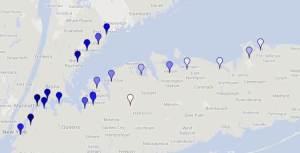2014 was an exciting year for Connecticut’s environment and Long Island Sound!Here are just a few of CFE/Save the Sound’s biggest victories this year:
- Officially opened a new Western Sound office with its own program director
- Helped save The Preserve after over 10 years and continued our fight to protect Plum Island
- Launched Stamford 2030 to make the city a leader in efficiency and resiliency
- Made transportation an issue in Connecticut’s gubernatorial race
- Worked in Connecticut’s legislature to stop toxic fracking waste from being brought into the state, to protect street trees, and to cut methane leaks
- Graded New York’s sewage treatment plants’ progress on cutting nitrogen
- Completed pollution-busting green infrastructure projects in New Haven, Plainville, and Wallingford and helped establish a state fund to increase GI statewide
- Made it safe for fish to migrate up the Pequonnock River in Bridgeport for the first time in 70 years
Read on to learn more about our accomplishments and for a few sneak peeks at 2015!
LAND
We helped preserve The Preserve!
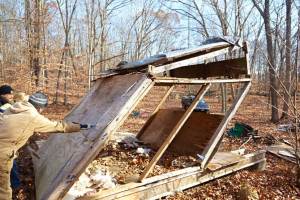
At the end of a decade-long legal battle led by CFE’s legal team, Old Saybrook’s 1,000-acre forest known as The Preserve is nearing permanent protection. Once slated to become a housing development and golf course, this prime piece of coastal forest—through the efforts of an amazing partnership of local advocates, conservation organizations like CFE and The Trust for Public Land, several towns, and the state—will remain a vital migratory bird stopover and drinking water aquifer forever. Old Saybrook residents voted overwhelmingly to support a $3 million bond package for protection, and residents of Essex voted to contribute $200,000. Now, in advance of the anticipated closing date in February 2015, our Chris Cryder is leading groups of volunteers in demolishing old shacks, as well as removing 1,400 percolation test pipes left by the developer.
Protecting Plum Island
We’ve been involved in ongoing negotiations with the General Services Administration to help protect this magnificent wildlife habitat located off the eastern tip of Long Island. Three boat excursions to Plum Island brought out nearly 80 people this year to see the island and help inspire further conservation efforts.

The first joint show of artists John Sargent (pastel and paint) and Bob Lorenz (photography) featured one of our favorite subjects: the stunning Plum Island. Held at the Acton Library in Old Saybrook, the paintings and photographs beautifully depict Plum Island, from the seals that call it home to migratory birds, and its historic military buildings and lighthouse.
In our first big act of 2015, we have notified the Department of Homeland Security and General Service Administration that we and Soundkeeper intend to file a lawsuit against them for violating the Endangered Species Act.
AIR
Clean air and clean energy
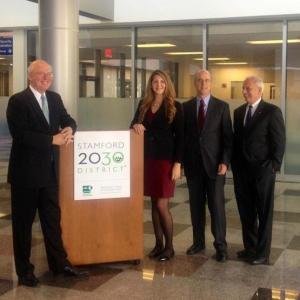
CFE, along with the Business Council of Fairfield County, launched the Stamford 2030 District, an initiative of property owners and community and professional partners working to reduce energy use, water use, and transportation emissions in the city. As just the sixth 2030 district in the country and the first in New England, the project will make Stamford a sustainability leader as well as a business leader. Under the leadership of executive director Megan Saunders, the district’s focus will also extend to resiliency as the city prepares for climate change and stronger storms.
We recently welcomed Shannon Smyth as our new energy and climate attorney. Shannon hails from the West Coast and has most recently been working in D.C. as an attorney for the Environmental Law Institute and the Environmental Defense Fund. She’s working on a new energy communications project that we’re excited to share with you soon.
 In September, several CFE/Save the Sound staff and board members joined 400,000 others in the streets of New York City in the largest climate march the world has ever seen. Along with proving to be a good staff bonding activity as we marching along NYC streets, the People’s Climate March reinvigorated our intentions to continue fighting climate change.
In September, several CFE/Save the Sound staff and board members joined 400,000 others in the streets of New York City in the largest climate march the world has ever seen. Along with proving to be a good staff bonding activity as we marching along NYC streets, the People’s Climate March reinvigorated our intentions to continue fighting climate change.
As a founding member of the New Haven Healthy City, Healthy Climate Challenge, we aim to help New Haven reduce local carbon emissions. In July, HCC ran the goNewHavengo campaign, encouraging the use of alternative transportation, like walking and biking, among those who live or work in the city. The coalition plans to focus on home energy efficiency projects this winter.
Transit: Getting around Connecticut

As Connecticut’s gubernatorial race shaped up to be another close contest, CFE co-hosted a candidate forum with fellow members of the Transit for Connecticut coalition, transportation construction organizations, and other allies. Governor Malloy and candidate Tom Foley shared their plans for the future of Connecticut’s transportation system with an audience of environmentalists, union members, and press. In conjunction with the forum, the coalition released their “Candidate Bulletin” laying out important transportation themes for the next governor.
The coalition followed it up with a public forum in early December entitled “Getting to Work: Transportation and Jobs Access for the 21st Century.” Transportation advocates and state officials gathered to discuss policies, funding opportunities, and innovation in advance of the January start of the legislative session.
We’re looking forward to the March 2015 opening of CTfastrak, the new rapid bus system that connects Hartford to New Britain and beyond. On a tour of the route in July, CFE employees saw first-hand the opportunities for transit oriented development (TOD) along the route. TOD combines economic growth and environmental protection by focusing housing, employment opportunities, amenities, and recreation near transit centers like CTfastrak offers. We look forward to joining you on the bus next year!
WATER
Waters of the Western Sound
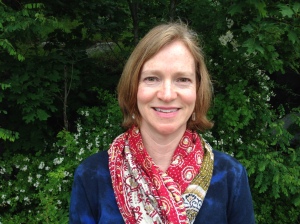
Our Western Long Island Sound program experienced a big boost this year, as we formally opened an office in Mamaroneck, New York and hired Tracy Brown to direct the program. Formerly of Riverkeeper, Tracy brings experience in sewage pollution and water quality monitoring. We’re glad to have her on board!
In our second annual summer survey of water quality, we increased the number of samples collected fourfold. We documented elevated levels of bacteria at locations in and around Mamaroneck Harbor, the Hutchinson River, and Eastchester Bay, confirming the presence of fecal contamination. We documented several illicit sewage overflows that have been fixed and continue to work with local communities to clean up contamination hot spots.
Shoreline residents and visitors lose access to Sound beaches for hundreds of days each year due to water pollution. Save the Sound is working to identify sewage leaks and other pollution sources and clean them up to ensure beaches are safe every day. We also had a letter on the need to repair Westchester’s sewers published in The New York Times. We’re now working on an online map that will let people check the health of beaches near them—look for it in 2015!
Our report card and interactive map “Healing the Sound’s Dead Zone: Are New York’s Sewage Treatment Plants Making the Grade?” tracked progress on reducing the excess nitrogen that contributes to Long Island Sound’s wildlife-smothering low-oxygen zone. Nassau and Suffolk counties have completed their upgrades on time, earning them an “A,” while Westchester County and New York City both received a “B” and require more work to reach the federally mandated nitrogen reduction targets by the 2017 deadline. The progress to date, and the long way still to go, bolsters our ongoing commitment to a healthy and vibrant Sound.
 In our pilot partnership with the Young American sailing team at Rye’s American Yacht Club, teen sailors became representatives of Save the Sound this summer. They sported a spinnaker sail with our logo at regattas and spread the word about the importance of a healthy Sound. We plan to expand to other youth sailing clubs next year.
In our pilot partnership with the Young American sailing team at Rye’s American Yacht Club, teen sailors became representatives of Save the Sound this summer. They sported a spinnaker sail with our logo at regattas and spread the word about the importance of a healthy Sound. We plan to expand to other youth sailing clubs next year.
Protecting Long Island Sound’s water, wildlife, and beaches
Our 23rd annual Long Island Sound Summit brought over 150 attendees together in New Rochelle to talk about the renewal of Long Island Sound’s Comprehensive Conservation and Management Plan on the eve of its 20th year. Attendees heard from a series of inspiring speakers in the morning and split into four groups in the afternoon to workshop each CCMP section: Sound Communities, Waters and Watersheds, Habitats and Wildlife, and Science and Management.
This summer, we launched the Long Island Sound Pledge across Connecticut and New York. Pledgers promise to take actions, like installing a rain barrel or reducing lawn fertilizer use, to help protect and preserve the Sound, as well as ask their friends to pledge too.
Thanks to our Clean Water Investment Coalition, Connecticut continued its strong record of clean water funding with historic levels of support for communities upgrading their wastewater and stormwater systems. We also worked with DEEP to set aside $20 million per year to promote and install green infrastructure that helps prevent flooding and sewage overflows, lets stormwater filter naturally into the ground, and beautifies cities.
In May, we hosted a fisheries forum at the UCONN Avery Point campus in Groton. A panel of scientists, fishermen, and educators held a lively discussion with audience members about the status of our nation’s ocean fisheries, the laws affecting them, and the impact of conditions in Long Island Sound and Connecticut’s rivers on various species.
We fought weakened restrictions on overfishing in the federal renewal of the Magnuson-Stevens Act that regulates all U.S. ocean fisheries. Successful action by our allies in the Herring Alliance increased the number of observers on vessels fishing for river herring—an important species in our region’s food web. In Connecticut, we successfully fought off a fishing season for juvenile eels that are currently being considered for Endangered Species status. Protecting fish at all levels of the food chain from being overfished helps makes both the environment and our economy stronger.
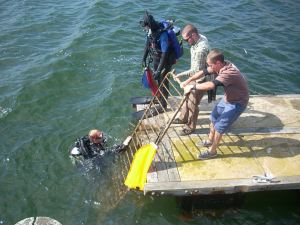 For two months this fall, we joined with citizen groups, businesses, bird watchers, fishermen, scuba divers, students, and kayakers in cleaning up nearly 50 beaches around Connecticut as part of the International Coastal Cleanup. In our two decades of coordinating the cleanup in Connecticut, we’ve gathered tens of thousands of volunteers to pull over 50 tons of garbage from our beaches and rivers. We send data on our finds to the Ocean Conservancy, which analyzes trends in marine debris to stop it at the source.
For two months this fall, we joined with citizen groups, businesses, bird watchers, fishermen, scuba divers, students, and kayakers in cleaning up nearly 50 beaches around Connecticut as part of the International Coastal Cleanup. In our two decades of coordinating the cleanup in Connecticut, we’ve gathered tens of thousands of volunteers to pull over 50 tons of garbage from our beaches and rivers. We send data on our finds to the Ocean Conservancy, which analyzes trends in marine debris to stop it at the source.
Restoring habitat for fish, wildlife, and people
 This spring, we completed a fish passage on the Pequonnock River at Bridgeport’s Glenwood Park, eliminating a dangerously shallow area that has impeded fish migration for 60 years. As the culmination of the project, we hosted a plant-a-thon to populate the riverbank with 2,100 native plants. About 70 volunteers joined Save the Sound for the planting, which will provide wildlife habitat and filter runoff to help keep the water clean.
This spring, we completed a fish passage on the Pequonnock River at Bridgeport’s Glenwood Park, eliminating a dangerously shallow area that has impeded fish migration for 60 years. As the culmination of the project, we hosted a plant-a-thon to populate the riverbank with 2,100 native plants. About 70 volunteers joined Save the Sound for the planting, which will provide wildlife habitat and filter runoff to help keep the water clean.
Save the Sound was awarded a $2.5 million grant for an upcoming project in the Governor Alfred E. Smith/Sunken Meadow State Park in King’s Park on Long Island. The funding will restore intertidal marsh habitat, use green infrastructure to reduce storm-related flooding in the main parking lot, analyze a possible fish passage, and educate visitors.
Green infrastructure helps our cities and our waters
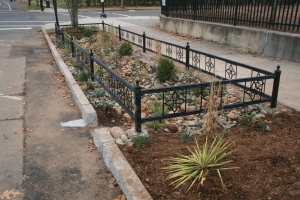
Kendall Barbery, our new Program Manager for Green Infrastructure, has kept busy with projects around Connecticut, especially in New Haven and Bridgeport. These green infrastructure projects, including the just-completed “bioswale” at Edgewood School in New Haven, capture rainwater and keep it out of the storm and sewer systems.
We installed 4,000 square feet of porous pavement at Plainville’s Trumbull Park this year as part of the Quinnipiac River Groundwater Recharge Project. The special surface, which contains small air spaces to let water run through to the ground rather than going into the storm sewer system, will let around 400,000 gallons of rainwater filter into the ground annually. Along with our porous pavement installation in Wallingford and the rain gardens we built in Southington in 2013, this will replenish drinking water supplies in the contaminated Quinnipiac River watershed.
A coalition of local environment and civic organizations revealed a watershed-based plan to improve water quality along the entirety of the West River, which runs through Prospect, Bethany, Woodbridge, Hamden, West Haven, and New Haven. Key issues the West River Watershed Coalition aims to tackle include polluted stormwater runoff, threats to wildlife habitat from development, mitigation of storm impacts like flooding, and improving public access along the West River.
ADVOCACY
Connecticut’s Legislative Session
 Successes in last year’s legislative session included a temporary ban on fracking waste in the state, stronger limits on leaking natural gas, and regulation of excess tree removal. Several bills that would have damaged citizens’ ability to help protect the environment were defeated.
Successes in last year’s legislative session included a temporary ban on fracking waste in the state, stronger limits on leaking natural gas, and regulation of excess tree removal. Several bills that would have damaged citizens’ ability to help protect the environment were defeated.
Methane from leaking gas pipes is an increasingly large contributor to climate change. We successfully supported the unanimous passage of a groundbreaking bill that limits unaccounted for methane leaks from the natural gas distribution pipes. The bill was signed by the Governor and will be implemented by PURA in the coming year. This is a preliminary but significant step in starting to deal with this growing problem.
The state will use the three-year moratorium on storing or treating toxic fracking waste in Connecticut to study the science around its impacts, and determine how to protect our waters and public health.
After several years of advocacy, the Vulnerable User bill passed this session, which levies fines on drivers who harm cyclists, pedestrians, and wheelchair users, making our roads safer for those not traveling in vehicles.
An ongoing battle over Connecticut Light and Power’s and United Illuminating’s tree-cutting plans included passage of a bill limiting excessive tree removal by including provisions for a DEEP review process and stronger property owner notification and objection procedures. Read more in the Enforcing Environmental Laws section below.
We joined with other environmental organizations to support a bill that would create a “Blue Plan” for Long Island Sound to identify the Sound’s most critical habitat areas and guide uses like fishing and shellfishing, industry, shipping, and recreation. We’re hopeful it will get over the finish line in 2015.
Bad bills that we helped to block this session included one waiving fines for first-time violators of regulations—sending the message that environmental regulations aren’t important—and a bill eliminating public hearings for proposed subdivisions.
Be sure to stay tuned to our blog for a preview of the upcoming 2015 legislative session, which begins on January 7!
Enforcing Environmental Laws
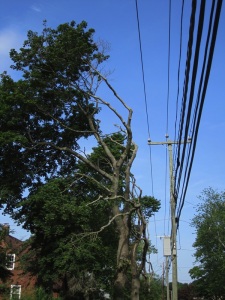
One of the biggest battles this year was over utility tree cutting. CL&P’s and UI’s plans too rigidly sought to remove or severely trim all tall-growing tree species within eight feet of power lines, regardless of tree health. CFE intervened in Public Utility Regulatory Authority (PURA) proceedings and successfully sought legislation that would curb some of the worst excesses on behalf of utilities. It is still largely up to municipalities, however, to invest the resources to protect their trees. CFE has been working with towns to develop the most effective strategies.
We settled eleven stormwater cases in 2014, most for illegal dumping from auto body shops and scrap metal recycling facilities, with around $90,000 paid to various remediation projects.
CFE/Save the Sound’s suit against the Great Neck Water Pollution Control District and the New York Department of Environmental Conservation ended last spring after Great Neck successfully completed its nitrogen upgrades so that the wastewater plant was no longer violating its Clean Water Act permits.
CFE/Save the Sound has intervened as a party in Connecticut Department of Energy and Environmental Protection (DEEP) proceedings to require stronger stormwater protections for municipal separate storm sewer systems (MS4). As the primary driver of water pollution in Connecticut, urban stormwater is a huge problem that needs to be addressed to comply with the federal Clean Water Act.
STAY INVOLVED
Annual Meeting
At our annual meeting in September, oceanographic explorer and famed conservationist Fabien Cousteau wowed CFE/Save the Sound members with tales from his recent Mission 31. We also presented three awards to organizations that have made extraordinary contributions to protecting our environment. The Westchester Community Foundation was honored for their support in protecting Long Island Sound, The Trust for Public Land for their enduring efforts to permanently protect The Preserve, and the Ridgefield Open Space Association for their work on Ridgefield’s Eureka lands. As always, the annual meeting provided a great opportunity to bring together our friends and supporters to celebrate our accomplishments and plan for the future.
Keep CFE/Save the Sound going strong!
If you like what you’ve seen over the last year and want to help support us in 2015, we have launched two new giving programs. Members of The Green Team, our monthly giving program, contribute to CFE or our Save the Sound program through secure, automatic credit card payments that provide a predictable income stream and eliminate paper renewal reminders. Green Team members receive our quarterly newsletter to keep them up-to-date on all our work. We’ve also launched a Tribute Card program so that anyone can make a gift in in honor of someone in their life—for a special holiday, a birthday, or in memoriam. You can also get regular updates on our work straight to your inbox by subscribing to our activist network. You make our work possible!

